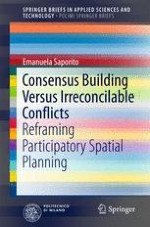
2016 | OriginalPaper | Buchkapitel
1. New Challenges for Participatory Approaches in Spatial Planning
verfasst von : Emanuela Saporito
Erschienen in: Consensus Building Versus Irreconcilable Conflicts
Aktivieren Sie unsere intelligente Suche, um passende Fachinhalte oder Patente zu finden.
Wählen Sie Textabschnitte aus um mit Künstlicher Intelligenz passenden Patente zu finden. powered by
Markieren Sie Textabschnitte, um KI-gestützt weitere passende Inhalte zu finden. powered by